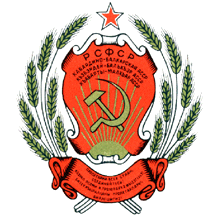Kabardino-Balkar Autonomous Soviet Socialist Republic
| Kabardino-Balkar Autonomous Soviet Socialist Republic Кабардино-Балкарская АССР (Russian) Къэбэрдей-Балъкъэр АССР (Kabardian) Къабарты-Малкъар АССР (Karachay-Balkar) | |||||||||
|---|---|---|---|---|---|---|---|---|---|
| 1936–1991 | |||||||||
 Flag
 Coat of arms
| |||||||||
.svg.png) Location of the Kabardino-Balkar ASSR within the Russian SFSR. | |||||||||
| Status | Autonomous republic of the Russian SFSR | ||||||||
| Capital | Nalchik | ||||||||
| Government | Autonomous Soviet Socialist Republic | ||||||||
| History | |||||||||
• Established | 1936 | ||||||||
| 1944 | |||||||||
• Name restored | 1957 | ||||||||
• Disestablished | 1991 | ||||||||
| |||||||||
The Kabardino-Balkar Autonomous Soviet Socialist Republic was an autonomous republic of the Russian Soviet Federative Socialist Republic, in the former Soviet Union, and was originally a part of the Mountain Autonomous Soviet Socialist Republic. On 16 January 1922 the region was detached from the Mountain ASSR and the Kabardino-Balkar Autonomous Oblast on 1 September 1921. It became an autonomous republic on 5 December 1936. On 30 January 1991, the Kabardino-Balkar ASSR declared state sovereignty.[1] It is now the Kabardino-Balkaria republic, a federal subject of the Russian Federation. The Kabardino-Balkar ASSR bordered no other sovereign states during the existence of the Soviet Union.
Like the Chechen-Ingush Autonomous Soviet Socialist Republic, the Kabardino-Balkar ASSR was shared by two nationalities. Both autonomous republics resided as part of the Russian Soviet Federative Socialist Republic and featured Russians as the ethnic majority.[2]
History
Both the Russian and Ottoman empires fought for the region between the 17th and 19th centuries, during which the region was under Russian control. After the October revolution, the region joined the Mountain Autonomous Soviet Socialist Republic in 1921, during the Russian Civil War. The territories were detached from the Mountain ASSR to the Kabardino-Balkar Autonomous Oblast in 1922, and on 5 December 1936 it was renamed the Kabardino-Balkar Autonomous Soviet Socialist Republic.[2][3]
In 1944, Supreme Soviet Joseph Stalin accused the Balkars of cooperating with Nazi Germany and deported the entire population to Central Asia.[3][4] Stalin ceded the Baksan valley to the Georgian SSR.[5] "Balkar" was dropped from the state's name, which was renamed to the Kabardin ASSR. The Balkar population was only allowed to return in 1957 during Khrushchev's leadership, at which point its pre-war name was restored.[5]
Geography
The Kabardino-Balkar Autonomous Soviet Socialist Republic was located in the North Caucasus mountains. It covered an area of 12,500 km2 (4,800 sq mi).
Rivers
The main rivers include the Terek River (623 km), Malka River (216 km), Baksan River (173 km), Urukh River (104 km), and Cherek River (76 km).[4]
Lakes
An area of 18,740 km2 (7,240 sq mi) is covered solely by river basins. More than 100 lakes are located in the borders, although none of them has very large surface area.[4] Most of the lakes are located in the mountains, formed by glacial processes.[4] Lakes located on a plain include Tambukan Lake.
Mountains
Mount Elbrus (5,642 m) is volcanic and the highest peak in the Caucasus.[3]
Other major mountains include Mount Dykhtau (5,402 m), Mount Koshkhatau (5,151 m), and Mount Shkhara (5,068 m).
Resources
Along with timber, the mining of minerals such as iron, molybdenum, gold, coal, tungsten, and lead were a main industry in the Kabardino-Balkar ASSR.[3] The region also has a great abundance of mineral water.[4]
See also
References

- ↑ "Russian S.F.S.R. Autonomous Republics". Retrieved 12 July 2011.
- 1 2

- 1 2 3 4 "BBC News - Kabardino-Balkaria profile". BBC Online. 19 January 2011. Retrieved 10 July 2011.
- 1 2 3 4 5 "Kommersant - Russia's Daily Online". Kommersant Publishing House. Archived from the original on 6 June 2011. Retrieved 10 July 2011.
- 1 2 "An article from The Columbia Electronic Encyclopedia". Columbia University Press. Retrieved 13 July 2011.
